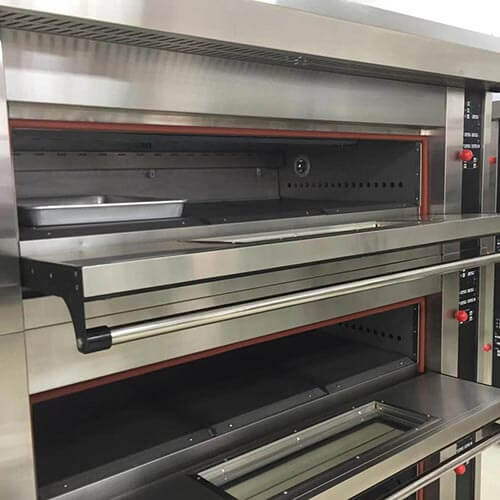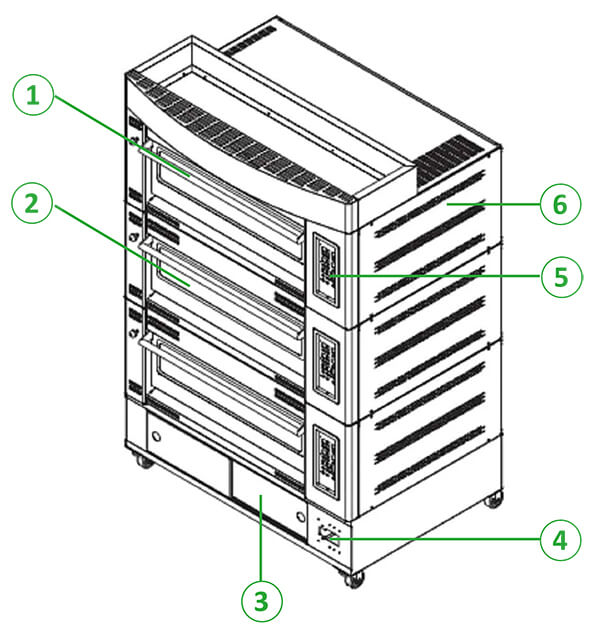Table of Contents
Deck Oven
As an industry leader in deck ovens, we strive to stay ahead of the curve by providing the latest technology, superior craftsmanship, and superior customer service.
What is a deck oven?
A deck oven is a type of commercial oven that is used to bake a variety of products, such as breads, pastries, pizzas, and other baked goods. Deck ovens are usually made up of two or more decks that each contain its own heating elements. This allows the user to control the temperature in each deck separately and bake different types of products at the same time. Deck ovens are perfect for bakeries, pizzerias, and other foodservice establishments that need to produce large amounts of high-quality baked goods quickly.

How does a deck oven work?
A deck oven is an efficient and popular way of baking. The oven consists of one or more enclosed compartments that heat the dough or other food items on top of the oven’s base. The oven is heated by gas, electricity, and the temperature is regulated by a thermostat.
Deck ovens are usually built with several decks, with each of the decks heating the food from heating mechanisms inside. The deck oven typically has an adjustable thermostat, which allows you to dial in the desired baking temperature. You can also control the amount of heat produced by the oven.

- Deck handle
- Deck door
- Storage
- Breaker
- Control Panel
- Housing
The deck ovens are usually equipped with a timer, which allows for efficient baking. The oven door can be opened to check the progress of the food without having to stop the baking process. This makes the deck ovens efficient and versatile.
The heat in the oven is evenly spread across the food, which results in even baking. Deck ovens are known for their consistency because they produce the same results every time. This makes them ideal for baking large batches of bread or pizza.
Deck ovens are also very economical, since they use less energy than other types of ovens. This makes them a great choice for commercial use. They are also easy to maintain and clean.
Comparing Different Types of Deck Ovens to Find the Right Fit
When choosing a deck oven, it’s important to consider factors such as fuel type, size, price, and features.
Fuel Types
Deck ovens are available in different fuel types, including gas, electric. Gas-powered ovens tend to provide a more consistent temperature, while electric models may offer better precision.
Size
Deck ovens come in a variety of sizes, from small countertop models to large commercial ovens. Consider how much food you need to cook at one time, and how much space you have available in your kitchen.
Price
Deck ovens can range in price from a few hundred dollars to thousands of dollars. Decide how much you’re willing to spend before shopping, and make sure to check the features offered at different price points.
Features
When selecting a deck oven, look for features that will make baking easier, such as steam-injected baking, even heat distribution, and a timer to keep track of baking time. Other features to consider include convection baking, adjustable shelves, and digital controls.
Understanding the Benefits & Drawbacks of Using a Deck Oven
Every coin has two sides.
Benefits of Using a Deck Oven
- The size of a deck oven allows you to bake a large quantity of items, like pizzas and focaccias, all at once.
- The even heat circulation ensures that all the items are cooked evenly and consistently.
- A deck oven can reach higher temperatures than other types of ovens, which is beneficial for baking certain types of bread.
- Deck ovens also require less time to preheat than other types of ovens, meaning you can get started on baking right away.
- Deck ovens are typically more cheaper than other types of ovens.
Drawbacks of Using a Deck Oven
- Deck ovens are also big and bulky, so they require more space than other types of ovens.
- Deck ovens take longer to cool down than other types of ovens.
- The size of a deck oven may also make it difficult to reach items that are stuck in the back.
Maintenance and Cleaning Tips for Deck Ovens
It is important to regularly maintain and clean your deck ovens to ensure maximum efficiency. Here are some tips for keeping your deck ovens running smoothly:
- Make sure the deck oven is turned off and the power source is disconnected before beginning any cleaning.
- Clean the interior surfaces of the deck oven to remove any food residue or build-up. Use a soft cloth and a mild detergent or baking soda and water to clean the interior.
- Remove any crumbs or debris from the oven bottom. Use a vacuum cleaner or broom to clean out the oven bottom.
- Inspect the door and door seals of the oven. Make sure the seals are in good condition and are not cracked, torn, or worn out.
- Check the heating elements of the oven. Make sure they are not cracked or broken.
- Clean the exterior surfaces of the oven using a soft cloth and mild detergent or baking soda and water.
- Once the oven has been cleaned, turn it back on and test the heating elements to make sure they are working properly.
- If the oven has a built-in timer, make sure it is set properly and that it works.
- Check the control knobs on the oven to make sure they are in proper working order.
- Perform regular maintenance and inspections of your deck oven to ensure it is working properly and efficiently.
Alternatives to Deck Ovens
If you’re looking for alternatives to deck ovens, there are a few options you may want to consider. The three main alternatives are conveyor ovens, rotary ovens, and microwave ovens.
Conveyor Ovens
Conveyor ovens are a great option if you need to bake multiple products quickly with consistent results. They work best with products that can be placed on a conveyor belt, such as pizza, flatbreads, and baked goods like cookies and muffins. These ovens are heated either by gas or electricity and use a fan to evenly distribute the heat throughout the oven. The speed of the conveyor belt and the oven temperature can be adjusted depending on the product you’re baking.
Rotary Ovens
Rotary ovens are a good option for baking products that need to be turned during the baking process, such as cakes and pies. These ovens have multiple revolving shelves or trays, which are heated from the bottom. The products are placed on the shelves and as the shelves rotate, they are exposed to consistent heat from all angles. This helps to ensure that the products are baked evenly.
Microwave Ovens
Lastly, microwave ovens are great for quickly heating or reheating precooked food. They use microwaves to heat up food quickly and evenly, which is why they are often used for reheating leftovers. Microwave ovens are also great for cooking and baking items like potatoes, chicken, and cakes.
Whether you choose a conveyor oven, a rotary oven, or a microwave oven, all three offer great alternatives to deck ovens. They all bake food quickly and with consistent results, and with the right adjustments, you can get the desired results you’re looking for.
What can we do for you?
Our innovation centers around providing customers with the most advanced deck ovens on the market. We stay ahead of the game by utilizing the latest technology and engineering advancements to create ovens that are not only reliable and efficient, but also energy-efficient. Our ovens are built to last, and our engineering process ensures that they remain top of the line for many years to come.
Our commitment to quality is unparalleled. We use only the finest materials and components in our deck ovens, to ensure that they are built with the highest level of craftsmanship. We also carefully inspect and test each oven before it is shipped, to ensure that you are receiving a product that is of the highest quality.
Finally, our services are second to none. Our team is available to help you with any questions or concerns you may have, from before you purchase your deck oven to after you have been using it for years. We will do whatever it takes to make sure that you are satisfied with the oven you purchased from us.
Optional Configuration
- 1-20 trays available
- Gas or electric
- Digital and mechanical operating panel
- Steam system
- Stone plate
